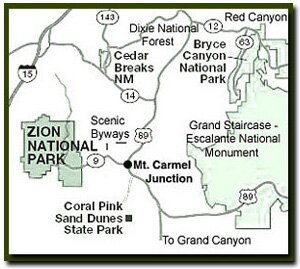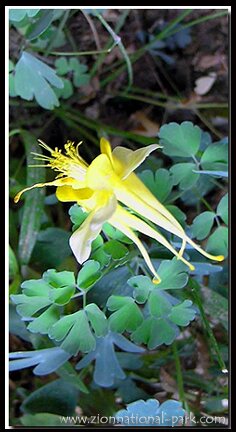
|
||||
|
Zion National Park Lodging Zion Info Vacation Weather Photos Hike Slot Canyons Backpack Camping |
||||
Plant life in Zion - Zion's FloraAlmost eight-hundred native species of plant life are found in the various zones of Zion National Park. Like many National Parks, Zion struggles to keep its native plants alive and thriving. Zion is the most visited National Park in Utah and the millions of visitors each year impact the habitats of the park's flora. Zion has its own nursery and greenhouse where it grows native plants that are used to replenish areas where the species have been destroyed. Hikers straying off the trails are a main factor in habitat destruction. The park uses a sophisticated database to keep track of the seeds sown and to ensure that native flora is planted back in its natural habitat. Foxtail and Rip-gut are two non-native grasses that create havoc in the park. Rip-gut has sharp edges and can harm animals that eat it. These unwanted grasses grow in many areas the park where the land has been disturbed. The grass that is seen in clumps is the native species of grass. The control of Tamarisk is another problem. It was brought into the US to control erosion, and it works well, but it is taking over the habitat of native species. Native cottonwood trees, which help control erosion, are planted along the Virgin River banks in Zion Canyon where the Tamarisk was removed.  Zion National Park Natural Life Zones Zion National Park Natural Life ZonesJust like the wildlife in Zion, the plant life changes as elevation changes. At about 5000 feet the pinions and juniper forests dominate. Moving higher, pine and oak trees are abundant. If we were to look at an even higher elevation we would see fir and aspen trees and heading up even higher, the spruce and fir become abundant. Evergreens - The evergreens, juniper and pine, are widespread throughout Zion. Juniper has a bluish berry-like fruit which takes two years to mature and the bark is fibrous and easily peels off its base. The early settlers made use of the easily frayed material for things like diapers, bedding, thread, needles and even skirts. The single-leaf pinion is the common pine seen on the rocky cliff sides in Zion National Park.
Poisonous Plants in Zion National Park - The sacred datura is common in Zion’s desert environment and has hallucinogenic qualities used by the ancient Indians that visited the area. They ground up parts of the plant and used the hallucinogen for male puberty rituals. Their reaction would tell the tribe if the child would have a long life or not. Avoid touching the datura or poison ivy, which is also found in the park, since some people have severe allergic reactions to them. That would make for a very unpleasant experience and ruin a vacation. The datura plant has large white trumpet shaped flowers that close in the hottest parts of the day. The plant thrives in dry lower elevations of the park and is seen all along the east section as well as in Zion Canyon.
Zion National Park, UtahHistory of the Thunderbird |
East Zion Lodge Mileage from Stay in the heart of the parks, Mount Carmel Junction, and visit the treasures of the Southwest and Utah. Site Map Zion Hiking
|
||||||||||||
|
This is my new favorite quote:
"I don't know who Mary Cisneros is, but I mean zionnational-park.com It's a better site than the NPS's anyway." Written by the authors of the book: Favorite Hikes in and around Zion National Park |
|||||||||||||
|
Zion History |
|---|
All rights reserved © Copyright Zion National-Park dot com
Do not use text, photos or maps without permission © Zion National-Park dot com
Contact the Author Mary Cisneros with any errors





